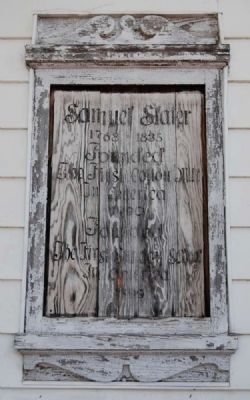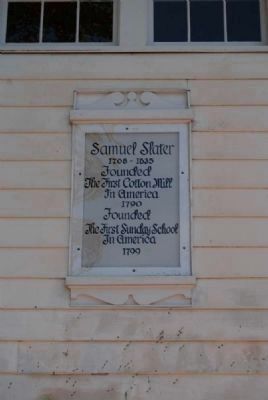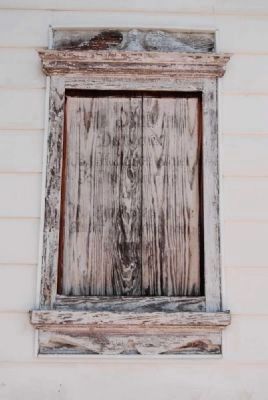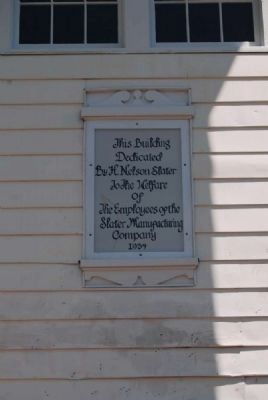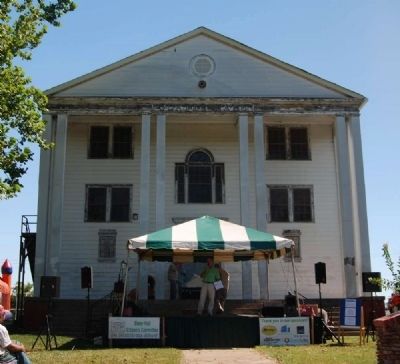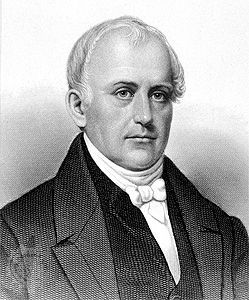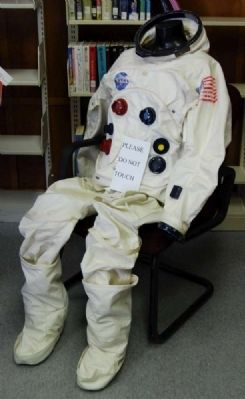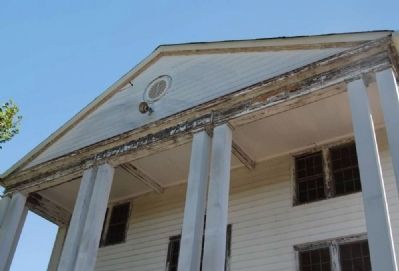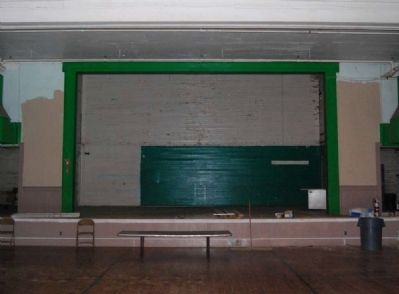Slater in Greenville County, South Carolina — The American South (South Atlantic)
Slater Hall
[Left Marker]
1768-1835
Founded
the first Cotton Mill
in America
1790
Founded
the First Sunday School
in America
1799
[Right Marker]
Dedicated
By H. Nelson Slater
To the Welfare
of
The Employees of the
Slater Manufacturing
Company
1934
Topics. This historical marker is listed in these topic lists: Churches & Religion • Education • Industry & Commerce. A significant historical year for this entry is 1790.
Location. 35° 1.757′ N, 82° 29.567′ W. Marker is in Slater, South Carolina, in Greenville County. Marker can be reached from Whitney Street. Markers are located on the east side of Slater Hall. Touch for map. Marker is at or near this postal address: 5 Whitney Street, Slater SC 29683, United States of America. Touch for directions.
Other nearby markers. At least 10 other markers are within 8 miles of this marker, measured as the crow flies. John Broadus Watson (approx. 3.9 miles away); John H. Goodwin House (approx. 4.7 miles away); John L. Plyler Home (approx. 4.9 miles away); Laodicea Langston Springfield (approx. 6 miles away); Mush Creek Baptist Church (approx. 6.3 miles away); Lynching in America / The Lynching of Tom Keith (approx. 6.9 miles away); Gap Creek Baptist Church (approx. 7 miles away); North Greenville Baptist Academy (approx. 7.4 miles away); Tigerville (approx. 7½ miles away); Furman University 50th Anniversary Plaza (approx. 7½ miles away).
More about this marker. Known by several titles: the Father of the the American Factory System, the Father of the Sunday School System, and the Father of the American Industrial Revolution.
Regarding Slater Hall. Slater, SC was named for Samuel Slater. He never actually visited the community nor had anything to do with the founding of the textile mill located there. However, the mill village took its name from the famed inventor.
Also see . . .
1. Slater Hall Citizen's Committee. The Slater Hall Citizen’s Committee is a group of concerned local area residents dedicated to the restoration of the Slater Hall property. (Submitted on July 22, 2009, by Brian Scott of Anderson, South Carolina.)
2. Samuel Slater. Samuel Slater (June 9, 1768 – April 21, 1835) was an early American industrialist popularly known as the "Father of the American Industrial Revolution" because he brought British textile technology to America. (Submitted on July 22, 2009, by Brian Scott of Anderson, South Carolina.)
3. Samuel Slater: Father of the American Revolution. It was in this mill in Pawtucket, Rhode Island that Samuel Slater began the American Industrial Revolution with the construction of the first successful textile mill in 1793. (Submitted on July 22, 2009, by Brian Scott of Anderson, South Carolina.)
4. Apollo 11. The Apollo 11 mission was the first manned mission to land on the Moon. (Submitted on July 22, 2009, by Brian Scott of Anderson, South Carolina.)
Additional commentary.
1. Material developed at Greenville's Slater Mill helped man walk on the moon
The Greenville News
By Amy Clarke, Staff writer
July 15, 2009
A relic of American history that helped an Upstate mill survive the crash of the domestic textile industry is coming out of a dusty attic after four decades to commemorate the giant leap for mankind.
The former Slater Plant in the northern corner of Greenville County was part of President John F. Kennedy's grand challenge of sending a man to the moon, producing one of the spacesuit fabrics used in the Apollo-era space missions, including the historic Apollo 11 moon landing on July 20, 1969.
A prototype suit was recently found at the plant, which operates today as JPS Composite Materials, and has become the center of a celebration about the history of the little mill village of Slater.
It's a history that began more than 80 years ago, when the plant started producing cotton sheeting and soon moved to making rayon cloth. The facility began producing fiberglass materials in 1951, a move that may very well have saved it amid the downturn in textiles in South Carolina.
It was that new material that found its way to the moon.
Today the plant's innovative practices are still contributing to the space program, producing quartz fabrics that are used in missile cones and other high-temperature applications on the space shuttle.
“It does reflect on America's greatest advantage historically, what some people used to call ‘Yankee ingenuity,' this creativity and ingenuity that comes forward,” said Bruce Yandle, dean emeritus at Clemson University's College of Business and Behavioral Science.
It's that drive that has kept the old Slater Plant operating even as the American textile industry has largely faded away, decimated by the migration to inexpensive foreign operations.
Jim Wilson, a manager at JPS, said his own great-grandfather worked and played ball at the mill decades ago.
“We've been still going strong,” he said, thanks to a spirit of ongoing adaptability that's kept the plant operating.
That, he said, and “the people actually take good pride in what they do.”
A local committee has been researching the history of Slater's role in the spacesuit and discovered the spirit of the time boiled down largely to a workaday sensibility.
Peter Godfrey, a local artist, is working on a documentary about the history, and has talked to several former workers who recalled their days making the “government cloth,” as they called it.
“Eh, it's a job,” was a common response, he said.
“And it occurred to us that, ‘Eh, it's a job,' is that steadfastness, that everyday, is that little part of history that Slater has a hold on.”
To honor that history and the small-town role in a big-time piece of history, the Slater Hall Citizens' Committee, in conjunction with the Greenville County Recreation District, is holding the From Mill to Moon festival Saturday, coinciding with the 40th anniversary of the Apollo 11 flight.
An astronaut from NASA will speak at the event, addressing “the connection between small-town America and this major space program … major advances that we've made,” said Karen Cleveland, committee chair. “It's through the efforts of small-town people going to work every day, working the third shift making the fabric.”
The research into the spacesuit's history has been slow-going, committee members said, because of a lack of documentation, although awareness of the plant's work permeated the community at the time.
“Everybody knew it. It was top secret in the '50s, but by the '60s, everybody knew it,” said Joe Wojeck. One of the plant manager's children even took the suit to school for show-and-tell around the time of the Apollo 11 landing.
But the stories faded from everyday lore. “It disappeared; no one knew,” said Joyce Ford, another committee member.
The rediscovery of Slater's history has inspired a newfound enthusiasm among community members, who are dredging up and swapping old memories of the time down at the “liars' club,” also known as the local hardware store.
“The stories are wonderful,” Godfrey said.
The events planned for the From Mill to Moon festival include a robotics demonstration, a downhill “rocket derby,” a children's space-themed parade and a “bluegrass opera” written especially for the occasion by Godfrey.
In a lighthearted salute, there are T-shirts with images of the moon landing reading, “Brought to you courtesy of Slater, South Carolina.”
The festival will be held from 10 a.m. until 4 p.m. Saturday at Slater Hall.
— Submitted July 22, 2009, by Brian Scott of Anderson, South Carolina.
Credits. This page was last revised on February 16, 2023. It was originally submitted on July 22, 2009, by Brian Scott of Anderson, South Carolina. This page has been viewed 7,465 times since then and 28 times this year. Photos: 1. submitted on July 22, 2009, by Brian Scott of Anderson, South Carolina. 2, 3, 4. submitted on December 4, 2011, by Brian Scott of Anderson, South Carolina. 5, 6, 7, 8, 9. submitted on July 22, 2009, by Brian Scott of Anderson, South Carolina.
